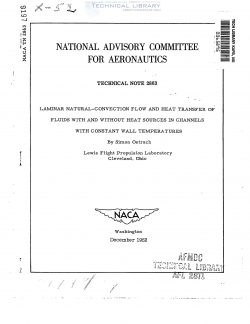naca-tn-2863
- Version
- 116 Downloads
- 1.61 MB File Size
- 1 File Count
- January 17, 2017 Create Date
- January 17, 2017 Last Updated
National Advisory Committee for Aeronautics, Technical Notes - Laminar Natural Convection Flow and Heat Transfer of Fluids with and without Heat Sources in Channels with Constant Wall Temperatures

The natural-convection phenomenon is analyzed and it is found that
the flow and heat transfer, in general, not only are functions of the
Prandtl and Grashof numbers but also depend on a new dimensionless
parameter. If this parameter is not negligibly small, the compression
work and frictional heating may appreciably affect this mode of heat
transfer.
Consideration is given to the particular case of fully developed
natural-convection flow of fluids with and without heat sources between
two parallel long plane surfaces the temperatures of which are main-
tained constant but not necessarily equal. These plates are oriented
in the direction parallel to the generating body force. Solution of
this problem yields detailed information on the velocity and tempera-
ture distributions and heat transfer to be expected for such flows
in tall narrow channels, on the effect of heat sources in the fluid,
and on the effect of frictional heating on the process. It is found
that the frictional heating and the heat sources increase the velocities
and temperatures within the channel formed by the two surfaces.
Increasing the ratio of the two wall-temperature differences (wall
minus outside ambient) also leads to similar results.
Flows which are generated entirely by the action of body forces
(such as the gravitational force) on fluids with density variations
due to heating are referred to as natural— or free-convection flows.
It has previously been pointed.out (see reference 1, for example) that
natural-convection flows are of practical importance in aeronautics.
The use of natural-convection flows in hollow passages in turbine rotor
blades for cooling is one of the applications of this phenomenon in
practice. With the advent of the possibility of nuclear power, the
natural-convection process becomes of even greater‘importance, because
this mode of heat transfer appears in some of the many schemes for
extracting the heat energy from an atomic pile. The use of liquid
metals (in which heat may also be generated by heat sources) as the
heat-transfer fluid for such applications is being considered because
of their suitable behavior at the high-temperature levels that would
be associated with atomic power.
| File | Action |
|---|---|
| naca-tn-2863 Laminar Natural Convection Flow and Heat Transfer of Fluids with and without Heat Sources in Channels with.pdf | Download |

Comment On This Post